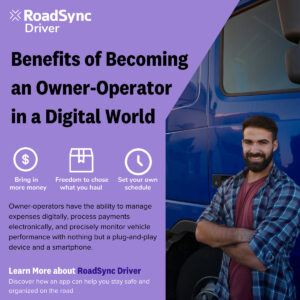Over the last few decades, technology has revolutionized the day-to-day operations of a number of professions, including professional driving. Advancements in technology have provided countless benefits to truck drivers, particularly owner-operators.
Thanks to truck driver apps and other solutions, owner-operators now have access to digital resources and capabilities that can make life on the road easier and more enjoyable for these dedicated entrepreneurs.
Below, we examine how driver tech has changed the journey to becoming an owner-operator and made this rewarding profession more appealing than ever before.
Truck Driver 101: Company Drivers vs. Owner Operators
Before we dive into how driver technology has changed the trucking industry, it is important to clarify the differences between company drivers and owner-operators.
As the name suggests, company drivers are employed by a commercial transportation carrier. The driver is responsible for maintaining their Class A commercial driver’s license (CDL) credentials and safely making deliveries using their assigned semi-truck and trailer.
However, the company handles all other aspects of logistics management. The company schedules the driver’s deliveries and pickups, maintains the vehicle, pays for insurance, purchases fuel, and buys any necessary permits.
Working for a company is appealing to some drivers because the business deals with the many complex aspects of operating in the transportation carrier industry.
Conversely, owner-operators have much more freedom and flexibility than company drivers. As you might have guessed, owner-operators own or lease their own semi-truck and trailer.
As the vehicle’s operator, they are responsible not only for making deliveries but also for scheduling loads, maintaining the truck, purchasing insurance, and other obligations. While owner-operators have far more responsibilities than company drivers, they also have better-earning potential and far more control over their work schedules.
How the Journey to Becoming a Truck Driver Has Evolved
Traditionally, truck drivers were disconnected from essential resources and information during their long journeys to their next drop-off location. While drivers have relied on basic communication tools like CB radios for years, these devices have very limited uses.
The rise of cell phones provided truck drivers with a much-needed lifeline that could prove invaluable, especially when traversing unforgiving stretches of road.
However, the emergence of smartphones represents the most significant change to the truck driving industry. Shortly after smartphones became widely available, several companies began developing driver tech that is designed to keep carriers connected during their travels.
Now, truck drivers can communicate with dispatch, maintain driving logs, pay for services, and request roadside assistance all from their internet-connected smart devices. This accessibility has made drivers far less dependent on dispatchers or support personnel while also allowing them to work more efficiently.
Aside from just increasing work efficiency, technology has also made daily life on a big rig much more palatable, particularly for a younger generation of drivers.
Video chat technology makes it easier to stay connected to family back home, making time away much less taxing. Streaming video and music services mean that an overnight in the sleeper cab includes almost all the comforts of home. Sophisticated budgeting and expense tracking software makes running a business as an owner operator seamless and simple.
All these technological advances can make the trucking life more attractive for younger professionals who may wonder about driving as a career. With a cell signal and some basic tech, the hardships of the road simply aren’t as hard as they used to be.
Key Considerations When Becoming a Carrier
Whether an individual is new to the transportation carrier profession or considering a transition from company driver to owner-operator, there are several things they must consider before making their move.
First and foremost, those interested in becoming an owner-operator must properly assess the costs of striking out on their own. In addition to the cost of the vehicle and trailer, owner-operators will need to purchase insurance, account for maintenance expenses, etc.
Ideally, an owner-operator should have some reserve funds in place to cover business expenses until they start generating revenue.
Aspiring owner-operators should also explore truck driver technologies like electronic logging devices (ELDs) and payment management applications. ELDs can help owner-operators reduce fuel waste and minimize insurance costs. Some ELDs also perform vehicle diagnostics and offer maintenance tracking capabilities.
Payment management applications can easily be installed on an owner operator’s smartphone. These apps act as a digital record keeper, creating, storing and sharing expenses and other documents, and helping facilitate faster over-the-road payments.
Modern expense and document management apps not only help drivers stay organized, they also give them more financial transparency, which is vital to their long-term success.
Benefits of Being an Owner Operator Transportation Carrier
Becoming an owner-operator offers several benefits over life as a company driver. Even after adjusting for an owner-operator’s increased overhead and out-of-pocket costs, these professionals typically bring in much more than other drivers. As long as owner-operators are working in compliance with federal driving regulations, they can work as much as they would like.
Over time, owner-operators can even add a few additional trucks to their fleet. While each of these trucks will bring in less revenue than the vehicle that the owner-operator is driving themselves, they can still boost their net revenue by a substantial amount.
One of the most appealing aspects of being an owner-operator is freedom. Independent drivers can choose who they want to work with and what they want to haul. This freedom is important to many people.
If an owner-operator wants to haul loads in a specific region of the country, they can only accept jobs in this geographical area. Conversely, adventurous owner-operators can select loads that will take them across the nation.
Owner-operators also set their own schedules. While they must keep busy to maximize their earning potential, they can also plan downtime or vacations in a manner that aligns with their personal preferences. This flexibility is a welcome change from traditional careers that offer restrictive leave options.

Reap the Benefits of Truck Driver Technology with RoadSync
There is no denying that truck driver technology has forever changed the transportation carrier industry. Most owner-operators can now access resources and digital tools that were previously reserved for major logistics companies.
Owner-operators have the ability to manage expenses digitally, process payments electronically, and precisely monitor vehicle performance with nothing but a plug-and-play device and a smartphone. However, in order to leverage these benefits, owner-operators must invest in the right driver tech, like the RoadSync Driver app.
If you are an owner-operator or considering becoming one, RoadSync can help you succeed with our innovative truck driver technology. To learn more, download the free RoadSync Driver mobile app today and find out why we are the preferred driver tech provider for countless professional transportation carriers.






